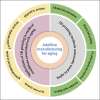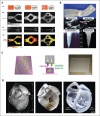Applications of 3D printing in aging
- PMID: 37323503
- PMCID: PMC10261158
- DOI: 10.18063/ijb.732
Applications of 3D printing in aging
Abstract
Aging is inevitable, and how to age healthily is a key concern. Additive manufacturing offers many solutions to this problem. In this paper, we first briefly introduce various 3D printing technologies commonly used in the biomedical field, particularly in aging research and aging care. Next, we closely examine aging-related health conditions of nervous system, musculoskeletal system, cardiovascular system, and digestive system with a focus on the application of 3D printing in these fields, including the creation of in vitro models and implants, production of drugs and drug delivery systems, and fabrication of rehabilitation and assistive medical devices. Finally, the opportunities, challenges, and prospects of 3D printing in the field of aging are discussed.
Keywords: 3D-printing; Aging; Biomaterials; Disease model; Regenerative medicine, Aging care.
Copyright:© 2023, Ma M, Gu J, Wang D-A, et al.
Conflict of interest statement
The authors declare no conflict of interest.
Figures





Similar articles
-
Powder Bed Fusion 3D Printing in Precision Manufacturing for Biomedical Applications: A Comprehensive Review.Materials (Basel). 2024 Feb 5;17(3):769. doi: 10.3390/ma17030769. Materials (Basel). 2024. PMID: 38591985 Free PMC article. Review.
-
Recent Advances in the Applications of Additive Manufacturing (3D Printing) in Drug Delivery: A Comprehensive Review.AAPS PharmSciTech. 2023 Feb 9;24(2):57. doi: 10.1208/s12249-023-02524-9. AAPS PharmSciTech. 2023. PMID: 36759435 Review.
-
3D Printing Technologies: Recent Development and Emerging Applications in Various Drug Delivery Systems.AAPS PharmSciTech. 2020 Aug 3;21(6):220. doi: 10.1208/s12249-020-01771-4. AAPS PharmSciTech. 2020. PMID: 32748243 Review.
-
Nanomaterial integrated 3D printing for biomedical applications.J Mater Chem B. 2022 Sep 28;10(37):7473-7490. doi: 10.1039/d2tb00931e. J Mater Chem B. 2022. PMID: 35993266 Review.
-
Biomaterials and 3D printing techniques used in the medical field.J Med Eng Technol. 2021 May;45(4):290-302. doi: 10.1080/03091902.2021.1893845. Epub 2021 Apr 30. J Med Eng Technol. 2021. PMID: 33929285
Cited by
-
Electromagnetic Wave-Absorption Properties of FDM-Printed Acrylonitrile-Styrene-Acrylate/Multi-Walled Carbon Nanotube Composite Structures.Polymers (Basel). 2025 Jul 23;17(15):2010. doi: 10.3390/polym17152010. Polymers (Basel). 2025. PMID: 40808059 Free PMC article.
References
-
- Giacomello E, Toniolo L. Nutrition, diet and healthy aging. Nutrients. 2021;14(1):190. https://doi.org/10.3390/nu14010190. - PMC - PubMed
-
- United Nations. United Nations, Department of Economic and Social Affairs, Population Division. World Population Prospects 2022. 2022
-
- Hou Y, Dan X, Babbar M, et al. Ageing as a risk factor for neurodegenerative disease. Nat Rev Neurol. 2019;15:565–581. https://doi.org/10.1038/s41582-019-0244-7. - PubMed
-
- Guo J, Huang X, Dou L, et al. Aging and aging-related diseases: From molecular mechanisms to interventions and treatments. Signal Transduct Targ Ther. 2022;7:391. https://doi.org/10.1038/s41392-022-01251-0. - PMC - PubMed
-
- 253Niccoli T, Partridge L. Ageing as a risk factor for disease. Curr Biol. 2012;22:R741–R752. https://doi.org/10.1016/j.cub.2012.07.024. - PubMed
Publication types
LinkOut - more resources
Full Text Sources
